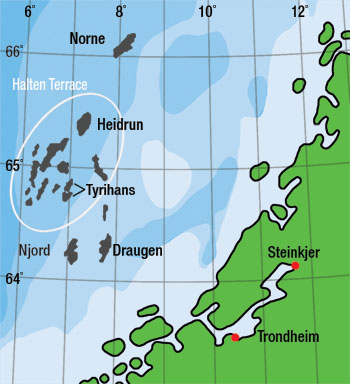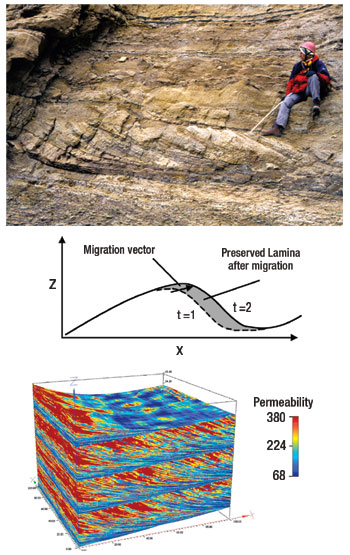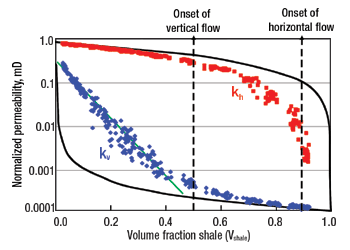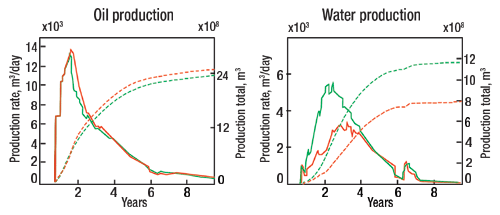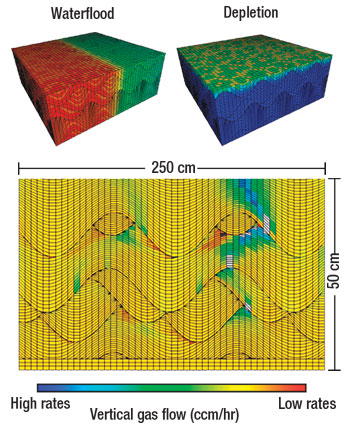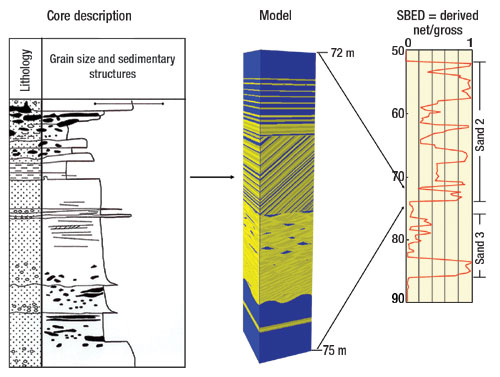Small-scale reservoir modeling tool optimizes recovery offshore Norway
Reservoir CharacterizationSmall-scale reservoir modeling tool optimizes recovery offshore NorwayModeling of small-scale bedding geometries improves recovery estimates in Norwegian oil fields, yielding added value of at least 16 million barrels.Carsten Elfenbein and Philip Ringrose, Statoil ASA; and Murray Christie, Geomodeling Technology Corp. Demands for improved oil recovery prompted the Norwegian oil company, Statoil, to evaluate geologically complex oil and gas-condensate fields offshore Norway with a new approach. Here, major sections of producing reservoirs are heterolithic tidal units of interlayered mud and sand. Using conventional modeling technology, Statoil geologists could not capture the fine-scale interlayering that would later impact their reservoir property simulations and reserve predictions. A unique multi-scale reservoir modeling tool developed by Geomodeling enabled Statoil to better understand its reservoir assets and choose the right strategies for optimized recovery. INTRODUCTION In the Halten Terrace tectonic province, mid-Norwegian Sea, Fig. 1, the heterolithic tidal units achieve recovery factors typically below 30%, much lower than the more than 60% recovery achieved in the North Sea’s Brent oil fields (e.g., Gullfaks, Statfjord).1 The difference is attributed to the highly heterogeneous character of Halten Terrace fields, which are structurally complex with large variations in sedimentary characteristics.
Compared to homogeneous reservoirs with few structural and sedimentary complexities, heterogeneous reservoirs have relatively low recovery factors, Fig. 2. This is due to the effects of compartmentalization, multi-phase flow and pressure development within the reservoir. These effects complicate reservoir predictions, drainage strategies and improved oil recovery (IOR) measures.
Statoil geologists recognized that the key to improving reservoir predictions was to model the observed heterogeneities in detail and evaluate their collective effect on flow properties. The reservoir properties that affect fluid flow and distribution – such as porosity, permeability and mud/ sand volumes – are governed by small-scale (cm-to-m scale) geometries occurring below conventional well log or seismic resolution. For example, grain size contrasts between mm-to-cm scale sand and mud lamina set up strong permeability anisotropy. This forces fluids to move along pathways controlled by bedding structures and mud/ sand ratios. A NEW APPROACH Today’s demands for faster reservoir cycle times, coupled with limited CPU capacities, have made it impractical or unfeasible to model small-scale bedforms with conventional techniques. Using SBED proprietary geological modeling software, Statoil successfully modeled the observed heterogeneities in Halten Terrace tidal units. These detailed models were then used to generate effective porosity and permeability values for input to large-scale reservoir simulations and reserve estimations. Results represent the real distribution of porosity and permeability in reservoir intervals, and provide more accurate reserve calculations and production profiles. Process-oriented modeling. The new modeling method follows a process-oriented approach. Process-oriented modeling of sedimentary structures mimics the products of sedimentary processes, such as bedform migration, erosion and deposition, without actually calculating the physics of grain movement or fluid flow. The method combines a vector-based movement of geometric surfaces through space and time with Gaussian simulation to create stochastic models of sedimentary structures and their associated petrophysical properties.2,3 This approach considers the stochastic nature of sedimentation and the spatial distribution of reservoir properties.4 The resulting models are highly realistic, Fig. 3.
Upscaling. Upscaling is the process of extrapolating fine-scale reservoir data (e.g., cm-scale core plug and m-scale well log data) to coarser scales, to populate reservoir grid cells up to hundreds of meters in size. Conventional modeling approaches can upscale the data statistically (e.g., by arithmetic, geometric or harmonic averaging) without considering the effects of fine-scale heterogeneities or data bias. When the upscaled data and associated errors are used to populate large-scale reservoir grids, the resulting reservoir simulations have a high degree of uncertainty. In the modeling workflow, sedimentary environments, such as fluvial, shoreface or deepwater facies, can be reproduced by creating stacked bedding models from over 100 bedding templates. These small-scale models are populated with petrophysical data (such as porosity and permeability) derived from core plug and well log measurements. The petrophysical models are upscaled by a range of methods, including averaging and flow simulation, to obtain effective properties for a given bedding structure. The resulting models incorporate the effects of sedimentary structure on flow properties.5 This approach enables upscaling without overloading the models with data or increasing model sizes. By comparing the effective property relationships derived from multiple SBED scenarios, a user can better discriminate between reservoir and non-reservoir intervals. CASE STUDIES The following Statoil case studies show how detailed small-scale modeling and upscaling, with SBED, impacted engineering and business decisions offshore Norway, Fig. 1. Case 1: Characterizing the Halten Terrace fields. Upscaled models were used to generate type curves showing the relationship between permeability and shale volumes in the Halten Terrace.5,6 The main reservoir units in these oil and gas-condensate producing fields are heterolithic tidal successions.1 The most heterogeneous intervals contain laminated sandstone/ mudstone units with wavy, lenticular and flaser bedding.7 Whole successions of tidal bedding facies were realistically represented in models. After populating the models with relevant petrophysical data and upscaling a number of realizations, the models generated type curves for permeability in tidal bedding. The type curves in Fig. 4 show the relationship between shale content and permeability in the Tilje formation of Heidrun field. Model dimensions are a few decimeters. Results indicate how much sand must be present before the reservoir will be producible (i.e., at the onset of vertical flow and horizontal flow). Traditionally, permeability estimates in tidal bedded reservoirs are derived from averaged core plug measurements and creative interpretation of well test data.
However, averaging of permeability in these bedding types may be misleading. For example, applying a harmonic average will usually underestimate the true effective vertical permeability, Fig. 4. This is due to complex mud-sand interlayering that allows for vertical connectivity between sands. The functional relationship from Fig. 4 was implemented in reservoir simulations to derive geologically based vertical permeability in tidal-influenced intervals. The resulting simulations helped to characterize reservoir properties in areas without well information. The type curve approach was also applied to a reservoir unit in Tyrihans field, where production of light oil is planned for startup in 2009.8 Fig. 5 shows predicted production profiles derived from two methods: 1) using kv/kh ratios calculated from small-scale geological models (green lines); and 2) using a constant kv/kh per reservoir zone (red lines).
In the model with geologically based kv/kh ratios, the predicted oil production decreases and the water output increases drastically, compared to the constant kv/kh case. The difference in produced oil is roughly 1MSm3. The type curve approach helped to reduce uncertainty in reserve predictions and allowed increased confidence in reserve estimates. Based on the results, Statoil engineers implemented a different strategy for design and installation of water treatment facilities in Tyrihans field. Case 2: Optimizing Statfjord field. After a hydrocarbon field in production has left its plateau phase, and rates begin to decline, the drainage strategy is often changed to optimize and possibly increase the field’s remaining lifetime. During Statfjord field’s late-life phase in the North Sea, Statoil implemented the modeling approach to evaluate alternative drainage strategies to gas injection. The two drainage options were: 1) Depletion (blow down) and 2) Alternating water and gas injection (WAG). The study’s aim was to incorporate the effects of small-scale heterogeneities in reservoir simulations and to understand how different parts of the reservoir respond to the respective processes.9 A combination of pore-scale models and lithofacies models was created for five different facies from the Jurassic Brent Group. Based on representative core intervals, generic lithofacies models were developed using the modeling approach. Input for models was based on single- and multiphase flow properties estimated from pore-scale network modeling. Models were then populated with petrophysical property values from core plugs and probe permeability measurements. These small-scale models were exported directly to the flow simulator, where two-phase, steady-state upscaling was used to derive effective properties, Fig. 6.
The results enabled Statoil to answer the questions surrounding fluid behavior and depressurization processes: How do gas fingers develop through the reservoir? Which layers are preferred water pathways? Where does oil remain? What is the critical gas saturation? The study also helped to define relative permeability curves for use in full-field production forecasts. The Statfjord late-life project has now been approved, and only time will tell how accurate the multi-scale production forecasts were. Case 3: "Go" or "No Go" in a deepwater study. The modeling approach was used in a deepwater field appraisal (undisclosed location, offshore Africa) to assess reservoir quality in highly heterolithic, thin-bedded sediments. Based on core descriptions, core plug measurements and an advanced suite of well log data, deterministic models of a 50-m cored interval were generated at cm-scale resolution, Fig. 7. Several model realizations were upscaled to a length-scale approximately equivalent to the resolution of the gamma ray (GR) curves from the same borehole. The upscaled results were used to generate a predicted net/ gross (N/G) curve in SBED, Fig. 7.
The new modeling-derived N/G curve was based on a geologically realistic distribution of sands and muds. Earlier estimations of N/G ratios were based on GR logs with different cut-off values for net sand. The resulting uncertainties from cut-off-based values were high, with N/G estimates ranging from 0.27 to 0.45, depending on the cut-off used. In comparison to modeling-derived N/G curves, cut-off-based curves tended to underestimate net sand in intervals with intermediate GR readings. Core descriptions and small-scale models showed that the sand intervals consist of thin-bedded, interlayered sandstone/ mudstone successions with good lateral connectivity. The improved estimation in net sand led to a "go" decision for further development in this deepwater field. Case 4: Increased IOR potentials at Heidrun. Improved oil recovery (IOR) potentials can be quantified, based on hydrocarbon volume estimates calculated with conventional and new modeling techniques. In Heidrun field, the estimated IOR volume potential that can be gained with conventional technology is <10 MSm3 of oil equivalent. In the tidal-influenced and highly heterolithic Tilje and Are formations, the estimated IOR volume potential using new technology is at least one order of magnitude higher, in the range of 10 – 100 million m3. Improved characterization of heterolithic reservoir intervals with small-scale modeling and upscaling methods has contributed to the higher IOR potentials. The value of small-scale heterogeneity modeling in Heidrun field was quantified in terms of its estimated share of IOR potentials. Assuming that small-scale modeling methods contribute a 5% share in IOR potentials, the volumes gained are impressive – at least 1.25 million m3 (or 8.0 million bbl) of oil using existing technology within a five-year timeframe, with longer-term potential for at least 2.5 million m3 (16 million bbls). Given the comparatively low cost of a reservoir characterization study using the modeling tool, ranging from $10,000 to $100,000 (depending on the study size), the economic risk associated with the study is minimal compared to the risk of bypassing or overestimating potential reserves. This more than justifies the cost of adding small-scale heterogeneity modeling to existing workflows. CONCLUSIONS Key challenges in reservoir modeling are to simulate reservoir behavior as accurately as possible while minimizing associated uncertainties. In combination with other tools, small-scale heterogeneity modeling can help to quantify reservoir uncertainty and mitigate geologic risk. In the case studies outlined here, the new method for geological modeling and upscaling has contributed significantly to well planning, project sanction and IOR strategies at Statoil. The potential return shows that detailed evaluation of marginal-quality heterolithic reservoirs is a worthwhile investment toward IOR actions offshore Norway. SBED is developed and distributed by Geomodeling Technology Corp., with contributions from Joint Industry Project partners BG Group, BHP Billiton, ConocoPhillips, ENI, ExxonMobil, Norsk Hydro, Shell, Statoil and Total. A recent capital investment from Offtech Invest AS, a subsidiary of Statoil, will accelerate commercialization to meet demands for more cost-effective recovery measures in the petroleum industry.
|
||||||||||||||||||||||||||||||||||||||||
- Advancing offshore decarbonization through electrification of FPSOs (March 2024)
- Subsea technology- Corrosion monitoring: From failure to success (February 2024)
- Driving MPD adoption with performance-enhancing technologies (January 2024)
- Digital transformation: A breakthrough year for digitalization in the offshore sector (January 2024)
- Quantum computing and subsurface prediction (January 2024)
- Offshore technology: Platform design: Is the next generation of offshore platforms changing offshore energy? (December 2023)
- Applying ultra-deep LWD resistivity technology successfully in a SAGD operation (May 2019)
- Adoption of wireless intelligent completions advances (May 2019)
- Majors double down as takeaway crunch eases (April 2019)
- What’s new in well logging and formation evaluation (April 2019)
- Qualification of a 20,000-psi subsea BOP: A collaborative approach (February 2019)
- ConocoPhillips’ Greg Leveille sees rapid trajectory of technical advancement continuing (February 2019)

